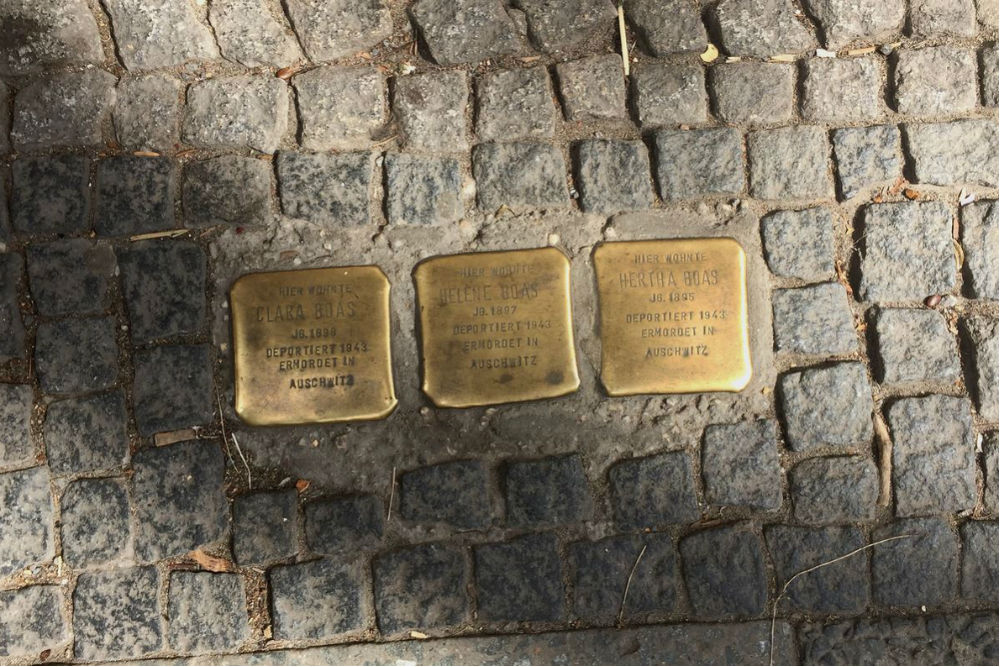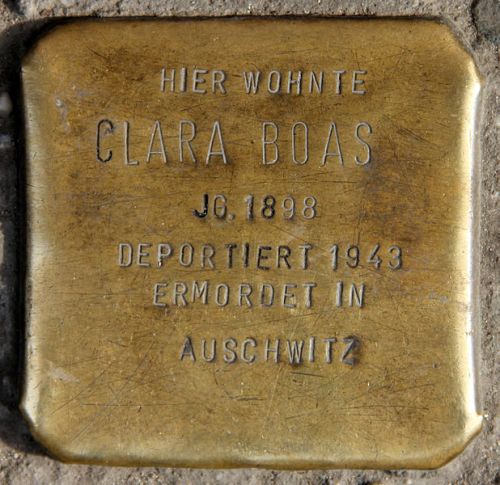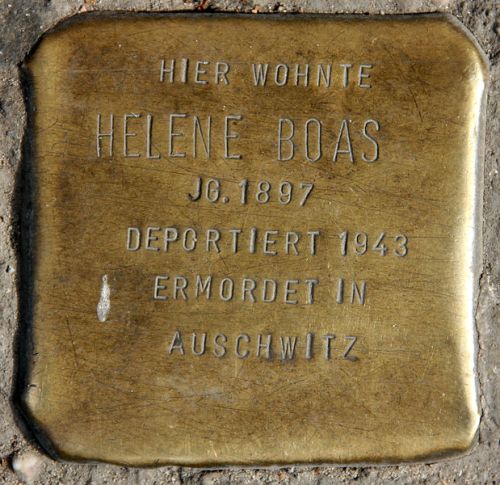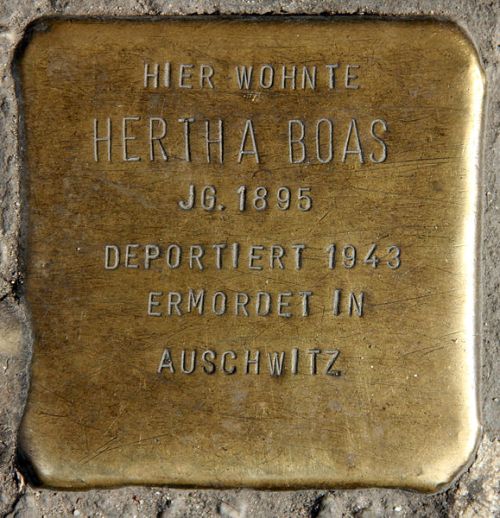Stumbling Stones Böckhstraße 49
These small, brass, memorial plaques (Stolpersteine or stumbling stones) commemorate:
* Clara Boas, born 1898, deported 1943, murdered in Auschwitz.
* Helene Boas, born 1897, deported 1943, murdered in Auschwitz.
* Hertha Boas, born 1895, deported 1943, murdered in Auschwitz.
The three Boas sisters – Clara, Helene, and Hertha – were born in Berlin. Helene and Clara were each born on 26 February, one year apart. During the Nazi times, they lived in a one-room apartment with kitchen. All three were forced laborers, each in a different company. Together they earned 79 Reichsmark per week, from which they paid RM38.75 for rent. The remainder was barely enough for food and essentials. One day after Helene and Clara’s birthdays in 1943, all three were picked up at work and arrested as part of the "Factory Action" to remove Jewish workers from factories. They had to give up all their belongings.
Three days later, on 1 March, Helene and Clara Boas were deported by train in closed cattle cars to Auschwitz, arriving the next day. Of the approximately 1,500 deportees, 150 men were selected for slave labor, and everyone else was sent directly to the gas chambers. On 3 March, Hertha Boas was deported to Auschwitz in another train of closed cattle cars packed with over 1,700 people. Approximately 500 men and 200 women were selected for slave labor; the rest were directly murdered in the gas chambers. Only 28 of the 1,726 are known to have survived the war, but Hertha was not among them.
"Stolpersteine" is an art project for Europe by Gunter Demnig to commemorate victims of National Socialism (Nazism). Stolpersteine (stumbling stones) are small, 10x10cm brass plaques placed in the pavement in front of the last voluntary residence of (mostly Jewish) victims who were murdered by the Nazis. Each plaque is engraved with the victim’s name, date of birth, and place (mostly a concentration camp) and date of death. By doing this, Gunter Demnig gives an individual memorial to each victim. One stone, one name, one person. He cites the Talmud: "A human being is forgotten only when his or her name is forgotten."
Do you have more information about this location? Inform us!
Source
- Text: Fedor de Vries & Anne Palmer
- Photos: Lorie Shaull (1), OTFW, Berlin (2), OTFW, Berlin (3), OTFW, Berlin (4)
- Stolpersteine in Berlin: The Boas sisters
- Yad Vashem Central Database of Shoah Victims’ Names
- Yad Vashem: Transport 31, 01 March 1943, Berlin-Auschwitz
- Yad Vashem: Transport 33, 03 March 1943, Berlin-Auschwitz
- Stolpersteine.eu
Nearby
Museum
- Bezirksmuseum Friedrichshain-Kreuzberg - Berlin-Kreuzberg
- Jüdisches Museum Berlin (Jewish Museum Berlin) - Berlin
- Luftschutzraum/Dokumentenbunker Tempelhof - Berlin
Point of interest
- Air-raid Shelter Fichtestraße - Berlin
- Desinfections Anstalt 1 - Berlin
- Bullet Impacts Altes Zollhaus Berlin - Berlin
Monument
- Memorial Synagogue Kreuzberg - Berlin-Kreuzberg
- Memorial Attack SA on Jewish Doctors - Berlin-Kreuzberg
- Memorial Arvid and Mildred Harnack - Berlin-Kreuzberg
Cemetery
- Lilienthalstraße German War Cemetery - Berlin
- German War Graves Berlin-Friedrichswerderscher - Berlin
- Garrison Cemetery Columbiadamm - Berlin
Remembrance Stone
- Stumbling Stones Böckhstraße 53 - Berlin-Kreuzberg
- Stumbling Stones Planufer 90 - Berlin-Kreuzberg
- Stumbling Stone Graefestraße 5 - Berlin-Kreuzberg









